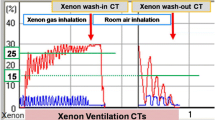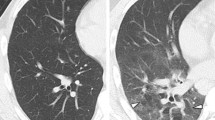Abstract
Objectives
To investigate the dynamic changes in airways in response to methacholine and salbutamol inhalation and to correlate the xenon ventilation index on xenon-enhanced chest CTs in asthmatics.
Methods
Thirty-one non-smokers (6 normal, 25 asthmatics) underwent xenon-enhanced chest CT and pulmonary function tests. Images were obtained at three stages (basal state, after methacholine inhalation and after salbutamol inhalation), and the total xenon ventilation index (TXVI) as well as airway values were measured and calculated. The repeated measures ANOVA and Spearman’s correlation coefficient were used for statistical analysis.
Results
TXVI in the normal group did not significantly change (P > 0.05) with methacholine and salbutamol. For asthmatics, however, the TXVI significantly decreased after methacholine inhalation and increased after salbutamol inhalation (P < 0.05). Of the airway parameters, the airway inner area (IA) significantly increased after salbutamol inhalation in all airways (P < 0.01) in asthmatics. Airway IA, wall thickness and wall area percentage did not significantly decrease after methacholine inhalation (P > 0.05). IA of the large airways was well correlated with basal TXVI, FEV1 and FVC (P < 0.05).
Conclusions
Airway IA is the most reliable parameter for reflecting the dynamic changes after methacholine and salbutamol inhalation, and correlates well with TXVI in asthmatics on xenon-enhanced CT.
Key Points
• In asthmatics, xenon ventilation decreases after methacholine and increases after salbutamol inhalation.
• Inner airway area (IA) correlates well with xenon ventilation.
• IA is the most reliable parameter reflecting airway changes in drug responses.




Similar content being viewed by others
Abbreviations
- CTDI:
-
CT dose index
- DLP:
-
dose length product
- FEV1 :
-
forced expiratory volume in 1 s
- FVC:
-
forced vital capacity
- IA:
-
inner area
- LMB:
-
left main bronchus
- PFTs:
-
pulmonary function tests
- RMB:
-
right main bronchus
- TXVI:
-
total xenon ventilation index
- WA%:
-
wall area percentage
- WT:
-
wall thickness
- WVI:
-
weighted ventilation index
References
Myers TR (2008) Guidelines for asthma management: a review and comparison of 5 current guidelines. Respir Care 53:751–767, discussion 767-759
Lynch DA, Newell JD, Tschomper BA et al (1993) Uncomplicated asthma in adults: comparison of CT appearance of the lungs in asthmatic and healthy subjects. Radiology 188:829–833
Woods AQ, Lynch DA (2009) Asthma: an imaging update. Radiol Clin North Am 47:317–329
Masoli M, Fabian D, Holt S, Beasley R (2004) The global burden of asthma: executive summary of the GINA Dissemination Committee report. Allergy 59:469–478
de Lange EE, Altes TA, Patrie JT et al (2007) The variability of regional airflow obstruction within the lungs of patients with asthma: assessment with hyperpolarized helium-3 magnetic resonance imaging. J Allergy Clin Immunol 119:1072–1078
Tzeng YS, Hoffman E, Cook-Granroth J et al (2008) Investigation of hyperpolarized He-3 magnetic resonance imaging utility in examining human airway diameter behavior in asthma through comparison with high-resolution computed tomography. Acad Radiol 15:799–808
King GG, Muller NL, Pare PD (1999) Evaluation of airways in obstructive pulmonary disease using high-resolution computed tomography. Am J Respir Crit Care Med 159:992–1004
Newman KB, Lynch DA, Newman LS et al (1994) Quantitative computed tomography detects air trapping due to asthma. Chest 106:105–109
Chon D, Simon BA, Beck KC et al (2005) Differences in regional wash-in and wash-out time constants for xenon-CT ventilation studies. Respir Physiol Neurobiol 148:65–83
Gur D, Drayer BP, Borovetz HS et al (1979) Dynamic computed tomography of the lung: regional ventilation measurements. J Comput Assist Tomogr 3:749–753
Gur D, Shabason L, Borovetz HS et al (1981) Regional pulmonary ventilation measurements by xenon enhanced dynamic computed tomography: an update. J Comput Assist Tomogr 5:678–683
Murphy DM, Nicewicz JT, Zabbatino SM, Moore RA (1989) Local pulmonary ventilation using nonradioactive xenon-enhanced ultrafast computed tomography. Chest 96:799–804
Snyder JV, Pennock B, Herbert D et al (1984) Local lung ventilation in critically ill patients using nonradioactive xenon-enhanced transmission computed tomography. Crit Care Med 12:46–51
Tajik JK, Chon D, Won C et al (2002) Subsecond multisection CT of regional pulmonary ventilation. Acad Radiol 9:130–146
Winkler SS, Nielsen A, Mesina J (1987) Respiratory depression in goats by stable xenon: implications for CT studies. J Comput Assist Tomogr 11:496–498
Chae EJ, Seo JB, Goo HW et al (2008) Xenon ventilation CT with a dual-energy technique of dual-source CT: initial experience. Radiology 248:615–624
Marcucci C, Nyhan D, Simon BA (2001) Distribution of pulmonary ventilation using Xe-enhanced computed tomography in prone and supine dogs. J Appl Physiol 90:421–430
Goo HW, Chae EJ, Seo JB, Hong SJ (2008) Xenon ventilation CT using a dual-source dual-energy technique: dynamic ventilation abnormality in a child with bronchial atresia. Pediatr Radiol 38:1113–1116
Park EA, Goo JM, Park SJ et al (2010) Chronic obstructive pulmonary disease: quantitative and visual ventilation pattern analysis at xenon ventilation CT performed by using a dual-energy technique. Radiology 256:985–997
Chae EJ, Seo JB, Lee J et al (2010) Xenon ventilation imaging using dual-energy computed tomography in asthmatics: initial experience. Invest Radiol 45:354–361
Park SJ, Lee CH, Goo JM et al (2012) Inter-scan repeatability of CT-based lung densitometry in the surveillance of emphysema in a lung cancer screening setting. Eur J Radiol 81:e554–560
Aysola RS, Hoffman EA, Gierada D et al (2008) Airway remodeling measured by multidetector CT is increased in severe asthma and correlates with pathology. Chest 134:1183–1191
Niimi A, Matsumoto H, Amitani R et al (2000) Airway wall thickness in asthma assessed by computed tomography. Relation to clinical indices. Am J Respir Crit Care Med 162:1518–1523
Lutchen KR, Jensen A, Atileh H et al (2001) Airway constriction pattern is a central component of asthma severity: the role of deep inspirations. Am J Respir Crit Care Med 164:207–215
Hoffman EA, Chon D (2005) Computed tomography studies of lung ventilation and perfusion. Proc Am Thorac Soc 2(492–498):506
de Lange EE, Altes TA, Patrie JT et al (2006) Evaluation of asthma with hyperpolarized helium-3 MRI: correlation with clinical severity and spirometry. Chest 130:1055–1062
Fain SB, Gonzalez-Fernandez G, Peterson ET et al (2008) Evaluation of structure-function relationships in asthma using multidetector CT and hyperpolarized He-3 MRI. Acad Radiol 15:753–762
Altes TA, Salerno M (2004) Hyperpolarized gas MR imaging of the lung. J Thorac Imaging 19:250–258
Lee EY, Sun Y, Zurakowski D et al (2009) Hyperpolarized 3He MR imaging of the lung: normal range of ventilation defects and PFT correlation in young adults. J Thorac Imaging 24:110–114
Schenzle JC, Sommer WH, Neumaier K et al (2010) Dual energy CT of the chest: how about the dose? Invest Radiol 45:347–353
Acknowledgements
This study was supported by a grant of the Korean Health Technology R&D Project, Ministry of Health & Welfare, Republic of Korea (A0810347).
Author information
Authors and Affiliations
Corresponding author
Rights and permissions
About this article
Cite this article
Park, S.J., Lee, C.H., Goo, J.M. et al. Quantitative analysis of dynamic airway changes after methacholine and salbutamol inhalation on xenon-enhanced chest CT. Eur Radiol 22, 2441–2450 (2012). https://doi.org/10.1007/s00330-012-2516-0
Received:
Revised:
Accepted:
Published:
Issue Date:
DOI: https://doi.org/10.1007/s00330-012-2516-0




